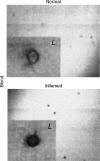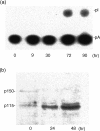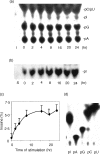Widespread inosine-containing mRNA in lymphocytes regulated by ADAR1 in response to inflammation
- PMID: 12709013
- PMCID: PMC1782949
- DOI: 10.1046/j.1365-2567.2003.01598.x
Widespread inosine-containing mRNA in lymphocytes regulated by ADAR1 in response to inflammation
Abstract
Adenosine-to-inosine (A-to-I) RNA editing is a post-transcriptional modification of pre-mRNA catalysed by an RNA-specific adenosine deaminase (ADAR). A-to-I RNA editing has been previously reported in the pre-mRNAs of brain glutamate and serotonin receptors and in lung tissue during inflammation. Here we report that systemic inflammation markedly induces inosine-containing mRNA to approximately 5% of adenosine in total mRNA. Induction was the result of up-regulation of A-to-I RNA editing as both dsRNA editing activity and ADAR1 expression were increased in the spleen, thymus and peripheral lymphocytes from endotoxin-treated mice. Up-regulation of ADAR1 was confirmed in vitro in T lymphocytes and macrophages stimulated with a variety of inflammatory mediators including tumour necrosis factor-alpha and interferon-gamma. A late induction of RNA editing was detected in concanavalin A-activated splenocytes stimulated with interleukin-2 in vitro. Taken together, these data suggest that a large number of inosine-containing mRNAs are produced during acute inflammation via up-regulation of ADAR1-mediated RNA editing. These events may affect the inflammatory and immune response through modulation of protein production.
Figures







Similar articles
-
ADAR1 is involved in the development of microvascular lung injury.Circ Res. 2001 May 25;88(10):1066-71. doi: 10.1161/hh1001.090877. Circ Res. 2001. PMID: 11375277
-
Editing of Cellular Self-RNAs by Adenosine Deaminase ADAR1 Suppresses Innate Immune Stress Responses.J Biol Chem. 2016 Mar 18;291(12):6158-68. doi: 10.1074/jbc.M115.709014. Epub 2016 Jan 27. J Biol Chem. 2016. PMID: 26817845 Free PMC article.
-
Serotonin-2C receptor pre-mRNA editing in rat brain and in vitro by splice site variants of the interferon-inducible double-stranded RNA-specific adenosine deaminase ADAR1.J Biol Chem. 1999 Jun 25;274(26):18351-8. doi: 10.1074/jbc.274.26.18351. J Biol Chem. 1999. PMID: 10373439
-
What do editors do? Understanding the physiological functions of A-to-I RNA editing by adenosine deaminase acting on RNAs.Open Biol. 2020 Jul;10(7):200085. doi: 10.1098/rsob.200085. Epub 2020 Jul 1. Open Biol. 2020. PMID: 32603639 Free PMC article. Review.
-
Editing of messenger RNA precursors and of tRNAs by adenosine to inosine conversion.FEBS Lett. 1999 Jun 4;452(1-2):71-6. doi: 10.1016/s0014-5793(99)00590-6. FEBS Lett. 1999. PMID: 10376681 Review.
Cited by
-
Increased levels of inosine in a mouse model of inflammation.Chem Res Toxicol. 2013 Apr 15;26(4):538-46. doi: 10.1021/tx300473n. Epub 2013 Apr 4. Chem Res Toxicol. 2013. PMID: 23506120 Free PMC article.
-
ADAR Mediated RNA Editing Modulates MicroRNA Targeting in Human Breast Cancer.Processes (Basel). 2018 May;6(5):42. doi: 10.3390/pr6050042. Epub 2018 Apr 25. Processes (Basel). 2018. PMID: 30197877 Free PMC article.
-
Genome-wide analysis of consistently RNA edited sites in human blood reveals interactions with mRNA processing genes and suggests correlations with cell types and biological variables.BMC Genomics. 2018 Dec 27;19(1):963. doi: 10.1186/s12864-018-5364-8. BMC Genomics. 2018. PMID: 30587120 Free PMC article.
-
Antiviral Defence Mechanisms during Early Mammalian Development.Viruses. 2024 Jan 24;16(2):173. doi: 10.3390/v16020173. Viruses. 2024. PMID: 38399949 Free PMC article. Review.
-
RNA editing of the human herpesvirus 8 kaposin transcript eliminates its transforming activity and is induced during lytic replication.J Virol. 2007 Dec;81(24):13544-51. doi: 10.1128/JVI.01521-07. Epub 2007 Oct 3. J Virol. 2007. PMID: 17913828 Free PMC article.
References
-
- Yang JH, Sklar P, Axel R, Maniatis T. Editing of glutamate receptor subunit B pre-mRNA in vitro by site-specific deamination of adenosine. Nature. 1995;374:77–81. - PubMed
-
- Melcher T, Maas S, Higuchi M, Keller W, Seeburg PH. Editing of alpha-amino-3-hydroxy-5-methylisoxazole-4-propionic acid receptor-B pre-mRNA in vitro reveals site-selective adenosine to inosine conversion. J Biol Chem. 1995;270:8566–70. - PubMed
-
- Rueter SM, Burns CM, Coode SA, Mookherjee P, Emeson RB. Glutamate receptor RNA editing in vitro by enzymatic conversion of adenosine to inosine. Science. 1995;267:1491–4. - PubMed
-
- Melcher T, Maas S, Herb A, Sprengel R, Seeburg PH, Higuchi M. A mammalian RNA editing enzyme. Nature. 1996;379:460–4. - PubMed
Publication types
MeSH terms
Substances
Grants and funding
LinkOut - more resources
Full Text Sources
Molecular Biology Databases
Research Materials

